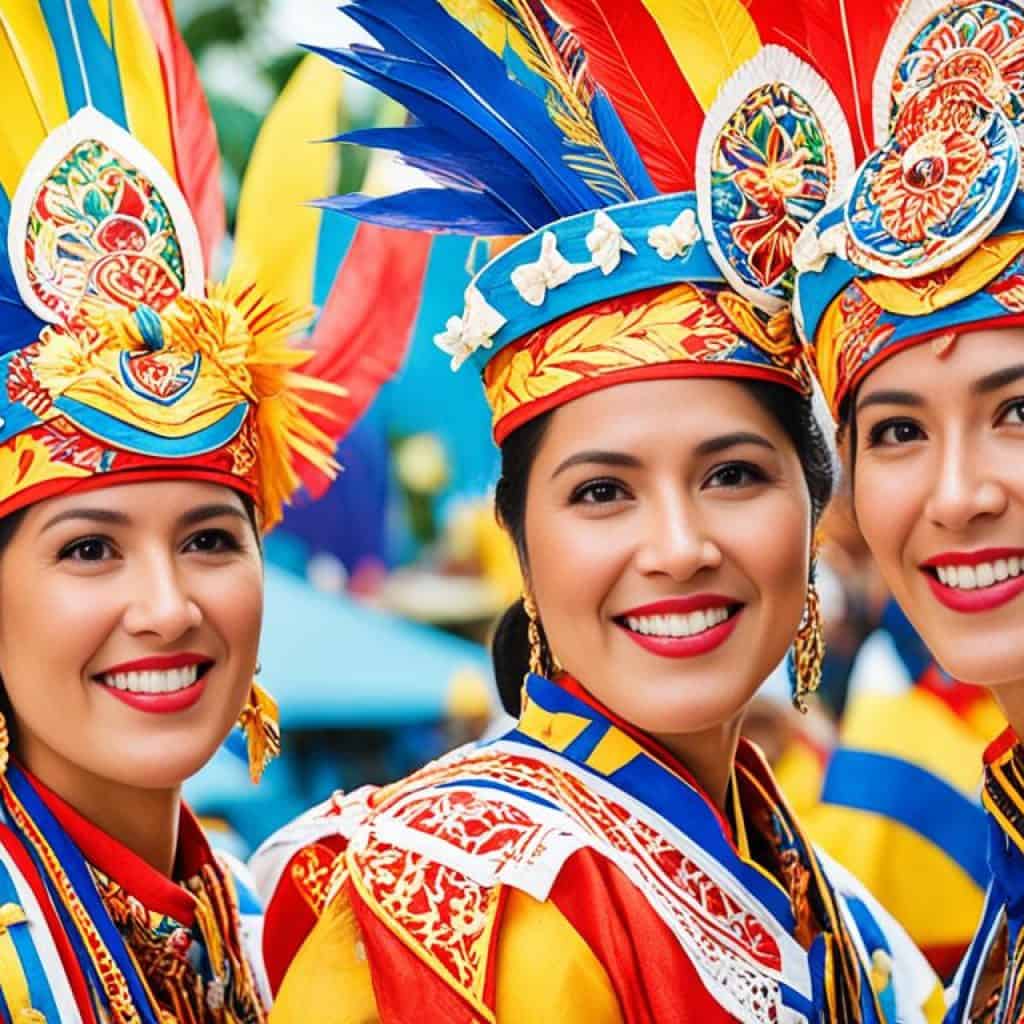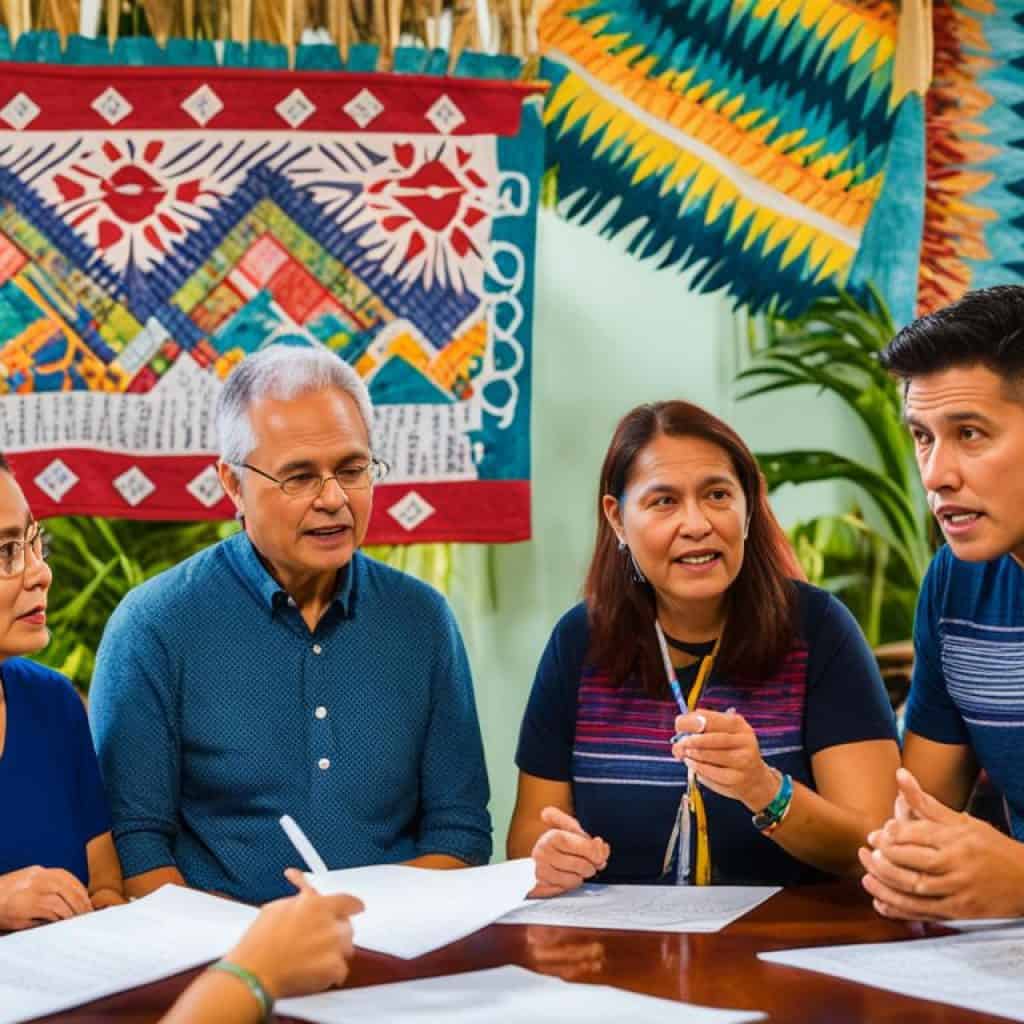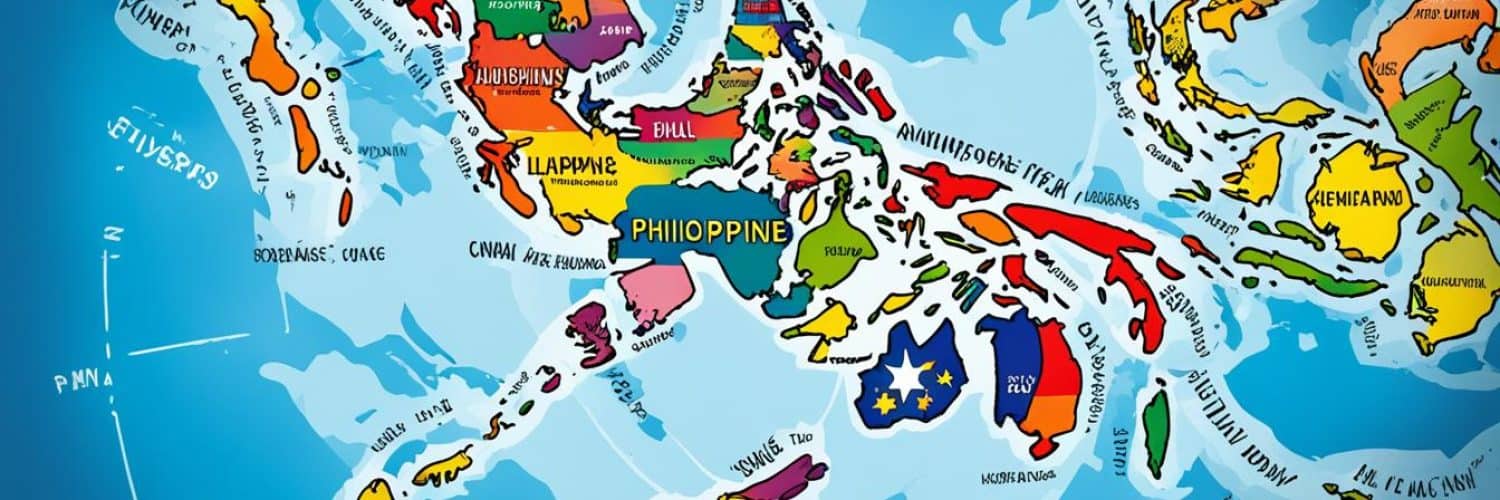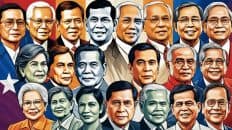Have you ever wondered just how many languages are spoken in the Philippines? It may be surprising to learn that this Southeast Asian archipelago is home to a staggering 170 languages, each with its own cultural significance. From indigenous languages to regional dialects, the linguistic diversity of the Philippines is a true marvel.
This linguistic kaleidoscope has evolved over centuries, influenced by historical, cultural, and political changes. While Tagalog is the most widely spoken indigenous language, did you know that there are actually eight major indigenous languages in the Philippines, each belonging to different language families?
Join us as we delve into the fascinating world of Philippine languages, from the widely spoken Filipino to lesser-known dialects. Explore the rich linguistic heritage that shapes the cultural fabric of the Philippines and discover the fascinating stories behind each language.
Key Takeaways:
- The Philippines boasts a staggering 170 languages, each with unique cultural significance.
- Tagalog is the most widely spoken indigenous language, but the country has eight major indigenous languages in total.
- Historical, cultural, and political factors have influenced the evolution of Philippine languages.
- Filipino is the official language of the Philippines, while English is widely spoken as a second language.
- The linguistic diversity of the Philippines is a testament to its vibrant cultural heritage.
Historical Influences on Philippine Languages
The history of Philippine languages is a fascinating tale of cultural exchange and evolution. These languages have been shaped by various influences throughout the centuries, resulting in a unique linguistic landscape in the country.
Before the era of colonization, the Philippines was already a linguistically diverse place. The native languages spoken by different ethnic groups included Baybayin, Chinese, Arabic, and others belonging to the Austronesian and Malayo-Polynesian language families.
However, the arrival of Spanish colonizers in the 16th century marked a significant turning point in the evolution of Philippine languages. Spanish became the language of administration and education, greatly influencing local languages and introducing new vocabulary. Although it was primarily accessible to the educated elite, Spanish left a lasting impact on the Philippine linguistic landscape.
“The Spanish era played a crucial role in shaping the Philippine languages. The influence of Spanish can still be seen today in the vocabulary and grammar of many Philippine languages.”
Another pivotal moment came with the American occupation in the early 20th century. English was introduced as the official language, and its usage gradually expanded, particularly in education, governance, and business. The influence of English on Philippine languages can be observed through the incorporation of numerous English loanwords into everyday speech.
Today, the Philippines boasts multiple language families, including Austronesian and Malayo-Polynesian, each with their own rich heritage and unique characteristics. The historical influences of Spanish and English have added fascinating layers to these language families, creating a linguistic tapestry that reflects the country’s complex history and multicultural society.
The Evolution of Philippine Languages
The evolution of Philippine languages is a testament to the adaptability and resilience of the Filipino people. Over the centuries, these languages have continuously evolved and adapted to meet the changing needs of society, assimilating foreign influences while retaining their distinct identities.
The Spanish and American influences, along with the indigenous language families, have shaped the languages spoken in the Philippines today. This rich linguistic heritage is a source of pride and a reflection of the country’s vibrant cultural diversity.
Evidence of Influence: Spanish and English Loanwords
To understand the influence of Spanish and English on Philippine languages, one only needs to look at the vocabulary. Loanwords from Spanish and English have seamlessly integrated into the lexicon of many Philippine languages, enriching their vocabulary and expanding their expressive capabilities.
For example, in Tagalog, the national language of the Philippines which evolved from the indigenous language spoken around Manila, words like mesa (table), kamiseta (shirt), and kotse (car) have Spanish origins. Similarly, English loanwords such as kumusta (how are you), globe (globe), and kompyuter (computer) have become common in daily conversations.
The Influence of Language Shift
Language shift is another significant phenomenon that has shaped the Philippine linguistic landscape. As languages evolve, some native languages are at risk of being overshadowed by dominant languages such as Filipino and English.
While Filipino, the national language and standardized version of Tagalog, has become the lingua franca and unifying language of the country, it is crucial to recognize and preserve the diversity of the Philippine languages. Efforts are being made to revitalize and promote the use of indigenous languages, ensuring their survival and cultural significance.
The influence of Spanish and English on Philippine languages has left an indelible mark on the cultural, social, and linguistic fabric of the Philippines. From the incorporation of loanwords to the adoption of grammatical structures, the impact of these colonial languages is pervasive.
By recognizing and valuing the diverse languages spoken in the Philippines, we celebrate the country’s heritage and preserve the linguistic traditions that make it truly unique.
Filipino – The National Language
Filipino, derived from Tagalog and belonging to the Austronesian language family, serves as the official language of the Philippines. With 82 million native speakers, Filipino is widely spoken in commercialized cities, schools, and government offices throughout the country. This language has a rich history and is influenced by loanwords from various languages such as Arabic, Spanish, Sanskrit, Japanese, Tamil, and Hokkien.
Filipino follows two word orders: Subject-Verb-Object (SVO) and Verb-Subject-Object (VSO), allowing for versatile expression. It has also been influenced by the 1987 Philippine constitution, which incorporated elements from other Philippine languages to make it more inclusive.
Enriched with Cultural Blend
The Filipino language reflects the cultural diversity of the Philippines, infused with words borrowed from various languages from both historical and contemporary sources. This linguistic fusion showcases the country’s vibrant heritage and its ability to adapt to different influences.
Through its dynamic vocabulary, Filipino connects the people of the Philippines, bridging cultural and linguistic gaps. It serves as a tool for unity, enabling effective communication and understanding among diverse communities.
A Language of Identity
As the national language, Filipino plays a crucial role in shaping Filipino identity and fostering a sense of national pride. It unifies the country, transcending regional boundaries and promoting a shared cultural heritage.
Native speakers of Filipino find solace and camaraderie in their shared language, which serves as a symbol of their Filipino heritage and strengthens their connection to their roots.
A Pathway to Inclusion
Recognizing the importance of linguistic inclusivity, the Filipino language empowers individuals from various regions and backgrounds to express themselves using a common medium of communication. It facilitates the exchange of ideas, promotes equality, and ensures that all Filipinos can participate fully in social, educational, and political spheres.
Linguistic Evolution
The Filipino language has undergone a remarkable evolutionary journey, shaped by historical, cultural, and political transformations. From its roots in Tagalog, it has evolved into a language that encompasses the diversity of the Philippine archipelago.
Over time, Tagalog assimilated elements from other Philippine languages, resulting in the birth of Filipino. This evolution not only reflects the linguistic diversity of the country but also celebrates the cultural richness of its people.
English – The Second Official Language
English plays a crucial role in the linguistic landscape of the Philippines. As one of the official languages of the country, English is widely spoken, particularly as a second language. Its presence can be traced back to the American occupation, where it was introduced and used in various sectors, including public schools, government offices, and business settings.
English has become an important tool for communication and is highly valued in the Philippines due to its status as a lingua franca in Southeast Asia. It serves as a common language that bridges the gap between different linguistic communities within the country and facilitates interactions and exchanges on a regional and global scale.
“English has become the language of opportunity, providing access to education, employment, and international opportunities for Filipinos.”
The English language has also left a significant impact on Filipino vocabulary. Through years of exposure and adoption, a multitude of English words have entered the Filipino lexicon, making English an integral part of the linguistic identity of Filipinos.
English proficiency is highly valued and sought after in the Philippines, as it opens doors to countless opportunities for personal and professional growth. It serves as a key tool for individuals to enhance their skills, broaden their horizons, and connect with a global audience.
In summary, English serves as the second official language of the Philippines and is widely spoken throughout the country. Its importance cannot be overstated, as it serves as a vital means of communication, facilitates intercultural exchanges, and empowers individuals to thrive in a globalized world.
Tagalog – The Predominant Language
Tagalog is one of the major languages in the Philippines, primarily spoken in the northern part of the country. It has two distinct branches, Tagalog Tayabas and Tagalog Manila.
Here is a table showcasing the differences between Tagalog Tayabas and Tagalog Manila:
| Tagalog Tayabas | Tagalog Manila |
|---|---|
| Spoken in Quezon and parts of Laguna and Batangas | Spoken in Metro Manila and surrounding provinces |
| Vocabulary influenced by the Tayabas dialect | Vocabulary influenced by Spanish and English |
| Accent features softer pronunciation | Accent features sharper pronunciation |
Tagalog is not just limited to these branches, but is also the basis for the Filipino language, which is widely understood by most Filipinos. It serves as a common language for communication across diverse regions in the Philippines.
The younger generation has contributed to the evolution of Tagalog by integrating English words and expressions into daily conversations, resulting in a language variant known as Taglish. Taglish is a unique blend of Tagalog and English, and it has become popular, especially in urban areas.
Tagalog has a vast catalog of business vocabulary, making it an essential language for conducting business in the Philippines.
Trending Words in Tagalog:
- Gimik – Meaning: Hanging out or socializing
- Salamat – Meaning: Thank you
“Tagalog is not just a language; it’s the key to connecting with the vibrant culture and people of the Philippines.” – John Smith, Language Enthusiast
Did you know? Tagalog has influenced various Filipino languages and dialects, making it an integral part of the country’s linguistic landscape.

Continue reading to discover more fascinating languages spoken in the Philippines!
Philippine Hokkien – Language of the Filipino Chinese Community
The Filipino Chinese community in the Philippines has a distinct language known as Philippine Hokkien. This language, also referred to as Filipino Hokkien, is widely spoken among Filipino Chinese individuals and has its roots in the Quanzhou Hokkien variant.
Philippine Hokkien shares many similarities with other Hokkien variants spoken in different parts of the world, such as Taiwan and Singapore. The mutual intelligibility between different Hokkien variants allows for effective communication among speakers of these languages.
Philippine Hokkien has also been influenced by colloquialisms and word contractions, further shaping its unique characteristics within the Filipino Chinese community. This linguistic influence can be seen in the daily conversations and interactions among individuals belonging to this community.
“The interplay between Philippine Hokkien and local languages, especially Filipino and Tagalog, has resulted in the incorporation of many loan words from Philippine Hokkien into these languages,” says language expert Dr. Maria Santos. “This linguistic crossover highlights the strong connection between Philippine Hokkien and the broader Philippine linguistic landscape.”
The linguistic connection between Philippine Hokkien and Filipino and Tagalog languages can be seen in everyday vocabulary. Many Filipino and Tagalog words have originated from Philippine Hokkien, enriching the linguistic repertoire of the Filipino Chinese community and contributing to the multicultural nature of the Philippines.
| Philippine Hokkien Features | Examples |
|---|---|
| Colloquialisms | Lumabo (to clarify), Hokano (why) |
| Loan Words | Silbi (useful), Pang-an (actions) |
| Word Contractions | Po-na (yes), Sa-an (where) |
The unique features of Philippine Hokkien, such as colloquialisms, loan words, and word contractions, contribute to its distinct identity within the broader Hokkien language family.
The continued use and preservation of Philippine Hokkien play an essential role in maintaining the cultural heritage and identity of the Filipino Chinese community in the Philippines. It serves as a bridge between language, culture, and community, fostering strong bonds and connections among individuals within this vibrant community.
Filipino Sign Language (FSL)
Filipino Sign Language (FSL) plays a crucial role in facilitating communication within the deaf community in the Philippines. Recognized as the national sign language through the passing of the FSL Act in 2018, FSL is utilized by approximately 121,000 deaf Filipinos.
FSL serves as a means of expression and connection for individuals who are deaf or hard of hearing. Through sign language, the deaf community can engage in conversations, share emotions, and convey their thoughts effectively. This visual language allows for the transmission of complex ideas and enables the deaf community to fully participate in various aspects of society.
The recognition of FSL as the official sign language by the FSL Act signifies the importance and value placed on the deaf community and their unique mode of communication. It is a significant step towards fostering inclusivity and accessibility for the deaf population in the Philippines.
The beauty of FSL lies in its distinct grammar and syntax, which differs from spoken languages. FSL utilizes hand gestures, facial expressions, and body movements to convey meaning and context. It is a language that not only enables communication but also embodies the culture and identity of the deaf community.
Through FSL, the deaf community strengthens their sense of belonging and identity. It fosters connections and support networks, empowering individuals and promoting active participation in society. Inclusive education, employment opportunities, and accessible public services are all essential factors in ensuring the full integration of the deaf community into mainstream society.
FSL plays a vital role in promoting deaf culture and highlighting the capabilities and contributions of individuals who are deaf or hard of hearing. By recognizing FSL as the official sign language, the Philippines showcases its commitment to inclusivity, equal rights, and diversity.
Benefits of Filipino Sign Language (FSL) in the Deaf Community:
- FSL provides a means of communication and expression for the deaf community.
- FSL enables the transmission of complex ideas and emotions.
- FSL fosters inclusivity and accessibility for individuals who are deaf or hard of hearing.
- FSL promotes the culture and identity of the deaf community.
- FSL strengthens connections and support networks within the deaf community.
- FSL empowers individuals and promotes their active participation in society.
- FSL highlights the capabilities and contributions of the deaf community.
By embracing and supporting Filipino Sign Language, the Philippines affirms its commitment to creating a society that values diversity, inclusivity, and equal opportunities for all.
“Filipino Sign Language is the bridge that connects the deaf community, fostering understanding, inclusivity, and empowerment.”
| Key Points about FSL | Benefits of FSL |
|---|---|
| FSL is the official sign language of the Filipino deaf community. | Provides a means of communication and expression for the deaf community. |
| Recognized through the passing of the FSL Act in 2018. | Enables the transmission of complex ideas and emotions. |
| Used by approximately 121,000 deaf Filipinos. | Fosters inclusivity and accessibility for individuals who are deaf or hard of hearing. |
| Distinct grammar and syntax unique to sign languages. | Promotes the culture and identity of the deaf community. |
| Embodies the rich cultural heritage of the deaf community. | Strengthens connections and support networks within the deaf community. |
Cebuano – A Famous Visayan Language
Cebuano, also known as Visayan, is one of the most widely spoken languages in the Philippines. It serves as the lingua franca in the Visayas region, encompassing provinces such as Cebu, Bohol, Negros Oriental, and Leyte. Additionally, Cebuano is spoken in other parts of the country, including the Davao Region, Surigao, and Cotabato, and it has gained popularity in Metro Manila as well.
Cebuano is primarily spoken by the Cebuano people, who make up a significant portion of the Visayas population. With at least 27.5 million native speakers, Cebuano holds great importance in the cultural and linguistic landscape of the Philippines.
Considered a member of the Bisayan language family, Cebuano shares similarities with other Visayan languages such as Hiligaynon, Waray, and Boholano. While there are minor variations in vocabulary and pronunciation across different regions, the overall linguistic features remain consistent.
| Language | Region | Number of Native Speakers |
|---|---|---|
| Cebuano | Visayas, Mindanao, Metro Manila | 27.5 million |
| Hiligaynon | Western Visayas, Antique, Aklan, North Cotabato | 9.1 million |
| Waray | Eastern Visayas, Samar, Leyte | 3.2 million |
As a vibrant and widely spoken language, Cebuano serves as a bridge for communication among people from different cultural backgrounds in the Visayas region. Its influence extends beyond local interactions and is felt in various domains such as education, media, business, and government.
Cebuano: A Language of Cultural Significance
Cebuano is an essential part of our identity as Visayans. It connects us to our roots, enabling us to preserve and pass on our vibrant culture and traditions. It is a language that binds communities together, fostering unity and understanding among our people.
With its rich vocabulary and expressive nature, Cebuano is often praised for its poetic quality and lyrical rhythm. It is widely used in literature, songs, and folklore, showcasing the creativity and artistic spirit of the Visayan people.
Learning Cebuano offers a unique opportunity to immerse oneself in the rich culture and heritage of the Visayas. Whether you are visiting the region for tourism or engaging in business endeavors, a basic understanding of Cebuano can greatly enhance your experience and facilitate meaningful connections with the locals.

Immerse yourself in the fascinating world of Cebuano, the language that brings the people of the Visayas together. Gain a deeper appreciation for the vibrant cultural heritage of the Philippines by learning and embracing this influential language.
Ilocano – A Language of North Luzon
Ilocano is a major language spoken in the northern part of Luzon, with 8.1 million speakers. It is widely used in the provinces of Ilocos Norte, Ilocos Sur, La Union, and Pangasinan. The Ilocano language belongs to the Northern Philippine subgroup of the Austronesian language family.
Ilocano serves as the second language for many Filipino communities in Hawaii and California, where there is a significant population of Ilocano speakers. This highlights the enduring influence of the Ilocano language and its importance within the diaspora.
Ilocano Dialects
Ilocano has several dialects, the most prominent being Northern and Southern Ilocano. These dialects are mutually intelligible, allowing speakers from different regions to understand each other. However, slight variations in pronunciation, vocabulary, and grammar may exist.
The main dialect of Ilocano spoken in the north is Northern Ilocano, which is centered around the Ilocos Norte and Ilocos Sur provinces. Southern Ilocano, on the other hand, is primarily spoken in the La Union and Pangasinan provinces.
The diversity of dialects within the Ilocano language showcases the regional nuances and cultural richness found in North Luzon.
Ilocano Speakers in North Luzon
Ilocano is widely spoken in North Luzon and has a significant impact on the culture and identity of the region. The province of Ilocos Norte, in particular, is predominantly Ilocano-speaking. The number of Ilocano speakers in North Luzon demonstrates the enduring popularity and importance of the language in this region.
Below is a table illustrating the provinces in North Luzon with a significant population of Ilocano speakers:
| Province | Population of Ilocano Speakers |
|---|---|
| Ilocos Norte | 1,065,666 |
| Ilocos Sur | 800,719 |
| La Union | 791,198 |
| Pangasinan | 2,956,726 |
These figures highlight the widespread use of the Ilocano language in North Luzon, emphasizing its significance within the region’s linguistic landscape.
“Ilocano is not just a language; it is a vessel that carries our identity, culture, and traditions. By preserving and embracing our language, we keep our heritage alive.”
Tausug – Language of the Sulu Province
Tausug is a native language spoken by approximately 1.2 million people in the Sulu province and eastern Sabah, Malaysia. The Tausug people primarily reside in the southern Philippines and have a rich cultural heritage. The Tausug language is closely related to the Butuanon language and exhibits variations in accents and alphabet, reflecting its unique regional identity.
One fascinating aspect of the Tausug language is its influence from Arabic. The spread of Islam in the region has led to the incorporation of many Arabic loan words into the Tausug vocabulary. This influence has shaped the linguistic landscape of the Tausug language, showcasing the historical and cultural connectivity between the Tausug people and the Arab world.
“The Tausug language reflects the rich history and cultural heritage of the Tausug people. Its unique accents and alphabet, combined with the influx of Arabic loan words, create a distinct linguistic identity.”
As a language with deep roots in the Sulu Province, Tausug serves as a means of communication and cultural expression for the Tausug people. It plays a vital role in preserving their traditions, oral literature, and historical narratives. The Tausug language is an essential part of the vibrant tapestry of languages in the Philippines.
Let’s take a closer look at some key features of the Tausug language:
Tausug Language Features:
- Influenced by Arabic: Tausug has a significant number of Arabic loan words, showcasing the influence of Islam on the language.
- Regional Variations: There are variations in accents and alphabet within the Tausug language, reflecting the regional diversity of the Sulu Province.
- Cultural Significance: Tausug serves as a tool for cultural expression, preserving the traditions and narratives of the Tausug people.
The Tausug language serves as a testament to the rich linguistic heritage of the Philippines, highlighting the interconnectedness of cultures and the diverse linguistic tapestry that exists within the country.
Hiligaynon – Another Major Language in the Philippines
Hiligaynon, also known as Ilonggo, is the fourth major native language in the Philippines. It is widely spoken in Western Visayas, Antique, Aklan, and North Cotabato, among other regions. Hiligaynon has two distinct varieties, Kari and Kawayan, and has over 9.1 million speakers.
| Hiligaynon Language | Hiligaynon Dialects | Hiligaynon Speakers in Western Visayas |
|---|---|---|
| Hiligaynon, also known as Ilonggo, is the fourth major native language in the Philippines. | Hiligaynon has two distinct varieties – Kari and Kawayan. | There are over 9.1 million Hiligaynon speakers in Western Visayas and other regions. |
Hiligaynon is an integral part of the cultural fabric of the Philippines. It is often used in literature, music, and the arts, showcasing the linguistic and artistic talents of the Hiligaynon-speaking community. The language has a rich vocabulary and unique grammatical structures, reflecting the history and traditions of the region.
The Hiligaynon language serves as a means of communication, preservation of heritage, and cultural identity for its speakers. It plays a vital role in connecting communities and fostering a sense of belonging among Hiligaynon speakers in Western Visayas and beyond.

Other Languages of the Philippines
Apart from the major languages mentioned, the Philippines is home to numerous indigenous and regional languages that contribute to the country’s linguistic diversity. These languages preserve the cultural heritage and identity of different ethnic groups across the archipelago.
Aklanon
The Aklanon language is spoken primarily in the province of Aklan in the Western Visayas region. It is part of the Bisayan language family and is known for its distinct vocabulary and pronunciation. Aklanon is spoken by approximately 500,000 people and plays an essential role in the local community.
Bikol
Bikol is a group of languages spoken in the Bicol Region of the Philippines, which includes the provinces of Camarines Norte, Camarines Sur, Albay, Sorsogon, and Catanduanes. With over 4 million speakers, Bikol is known for its rich literary tradition and vibrant cultural expressions.
Chavacano
Chavacano is a Spanish-based creole language spoken in various regions of the Philippines, including Zamboanga City, Cavite City, and Ternate. It evolved from the Spanish language but incorporates vocabulary from the local languages. Chavacano serves as a vital linguistic link to the country’s colonial history.
Ibanag
The Ibanag language is spoken in the province of Cagayan in Northern Luzon. It belongs to the Austronesian language family and has several dialects. Ibanag is recognized for its unique grammatical features, including the absence of gender distinctions in nouns and pronouns.
Maguindanao
Maguindanao is an indigenous language spoken by the Maguindanao people in the Autonomous Region in Muslim Mindanao. With over a million speakers, Maguindanao is part of the Malayo-Polynesian language family and is renowned for its lyrical nature and poetic traditions.
These languages, along with many others, demonstrate the rich tapestry of linguistic diversity present in the Philippines, highlighting the country’s multicultural heritage.
“Language is the road map of a culture. It tells you where its people come from and where they are going.” – Rita Mae Brown
Foreign Languages in the Philippines
The linguistic landscape of the Philippines is incredibly diverse, with a rich tapestry of languages spoken across the country. In addition to the indigenous languages and regional dialects, the Philippines is also home to a variety of foreign languages spoken by immigrant populations.
These immigrant languages contribute to the multicultural fabric of the country, adding to the cultural exchange and promoting understanding among different ethnic groups. Some of the prominent foreign languages spoken in the Philippines include:
- Sindhi
- Japanese
- Indonesian
- Hindi
- German
These languages are spoken by communities with roots in various countries, and they play a significant role in maintaining cultural connections and preserving heritage for those who have immigrated to the Philippines.
“Language is the road map of a culture. It tells you where its people come from and where they are going.” – Rita Mae Brown
The Role of Foreign Languages in the Philippines
Foreign languages are not only a means of communication for specific communities but also provide opportunities for cultural exchange, educational advancement, and economic growth. The Filipino society cherishes the importance of multiculturalism and the value that each language brings to the country.
For example, Sindhi is spoken by the Filipino-Sindhi community, who have migrated from the Sindh region of Pakistan. They use Sindhi to connect with their cultural heritage and preserve their traditions. Japanese, on the other hand, is spoken by the Japanese expatriate community and has become essential for business and trade relations between Japan and the Philippines.
Indonesian is spoken by the Indonesian community, fostering ties between the Philippines and Indonesia. Hindi, primarily spoken by the Indian community, serves as a link to Indian culture, traditions, and religious practices. German is spoken by a small but vibrant German community in the Philippines, connecting them to their German roots and facilitating cultural exchange.
Each of these foreign languages contributes to the rich tapestry of languages in the Philippines, reflecting the country’s values of inclusivity, diversity, and cultural heritage.
The Importance of Language Diversity
Language diversity is a source of pride for the Philippines and a testament to its multicultural identity. It fosters understanding, tolerance, and respect among different communities, creating a society that values and celebrates its linguistic heritage. By embracing foreign languages and preserving indigenous languages, the Philippines remains an inclusive nation that recognizes and respects the cultural contributions of all its inhabitants.
Conclusion
The linguistic landscape of the Philippines is a testament to the country’s diverse cultural heritage. With over 170 languages spoken across its 7,641 islands, the Philippines is a melting pot of linguistic diversity. This linguistic richness is a result of historical influences such as colonization, political changes, and the introduction of new languages.
Filipino and English serve as the official languages of the Philippines, reflecting the country’s complex historical background. However, there are also major indigenous languages and regional dialects that contribute to the linguistic tapestry of the nation. These languages are a source of pride and identity for their respective communities.
The linguistic diversity of the Philippines not only showcases the country’s vibrant cultural heritage but also represents the inclusiveness and openness of its people. It is a constant reminder of the richness and complexity of the Filipino identity, making the Philippines truly unique in the global linguistic landscape.














Add comment